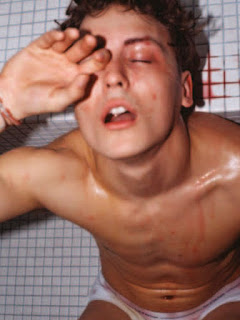by Vivien Lash
Aunt Irene the Slut was my first dead glamorous role model. She ran away to New York to lead a Valley of the Dolls existence, occasionally coming home to London for a bit of detox. Mixing an extra dry martini for breakfast, she'd whisper seductively, "If you want to keep your looks, Vivs, drink vodka."
Irene walked the tightrope between a good death and a bad end when a garbage truck reversed into her while stuck in a traffic jam between Fifth and Madison. She had just posted a birthday card to me with this message in Schiaparelli pink ink: "You can drink and take drugs, but not at the same time."
Happiness writes white, whereas silent Rothko red is the shade of suicide. Besides, deaths are easier to remember than birthdays, and a bad end is sexier than dying in your sleep. Suicide is a blind date with a dark stranger, a way of shouting Cut! when you’re still young, thin or fabulous.
Sylvia Plath’s poetry is good, but her dark demise said more than her platinum summer. Her death was "a kind of pornography, at once exciting and unreal," to quote Al Alvarez. He was the last man to whiff Plath’s hair as she ascended the stairs ahead of him a few days before she put her head in a greasy English oven.
A good death never hurt anyone’s career, as Marilyn Monroe could testify, if dead saints could talk. She died "in the nude," as Elton John, fairy godfather to the famous and unhappy, sings. Naked except for a squirt of Chanel No 5, a free product placement Karl Lagerfeld could only dream of achieving now.
Suicide is not the only form of self-destruction. It was only a matter of time before Princess Diana died in a car crash. She nearly found freedom before becoming the unfortunate face of a billion tacky souvenir tea towels. Which goes to show, death and glamour go together like sluts and STDs; you can't have one without the other.
John Galliano, too, met self-destruction, but of a different kind. It’s hard to believe that a man with Gallo’s post-punk talent and taste could fall for the little dude with the funny stache.
But an Anarchy shirt isn’t going to upset anyone these days. Sex and drugs aren’t shocking even in the schoolyard. In an increasingly PC world, ideological anarchy could be the only way left to be disturbingly decadent.
I always walk a little faster when I pass Alexander McQueen’s old apartment in Mayfair, where the genius grandson of punk died in his closet, of all places, or when I look in the window of the empty apartment in Eton Square, where his friend Issy Blow lived before swallowing weed killer. Depression and self-loathing are still in the air. Sunday will be two years since McQueen's passing; at least he's missed the ugly CrossRail Station going up nearby for the Olympics.
Death is in the details and there’s a romantic attraction to leaving before the party ends. Who wants to hang around long enough to grow too many chins for even a cosmetic surgeon to hack off?
After death, glamour lives on with a greed for fame like an X-Factor contestant without a song. And sometimes emptiness is attractive, waiting to be filled by the reflection of one's own fantasies. As Aunt Irene the Slut used to say, while admiring her reflection in the bottom of a cocktail glass, "A dead glamorous obsession beats talking about the weather."
(hint)






















